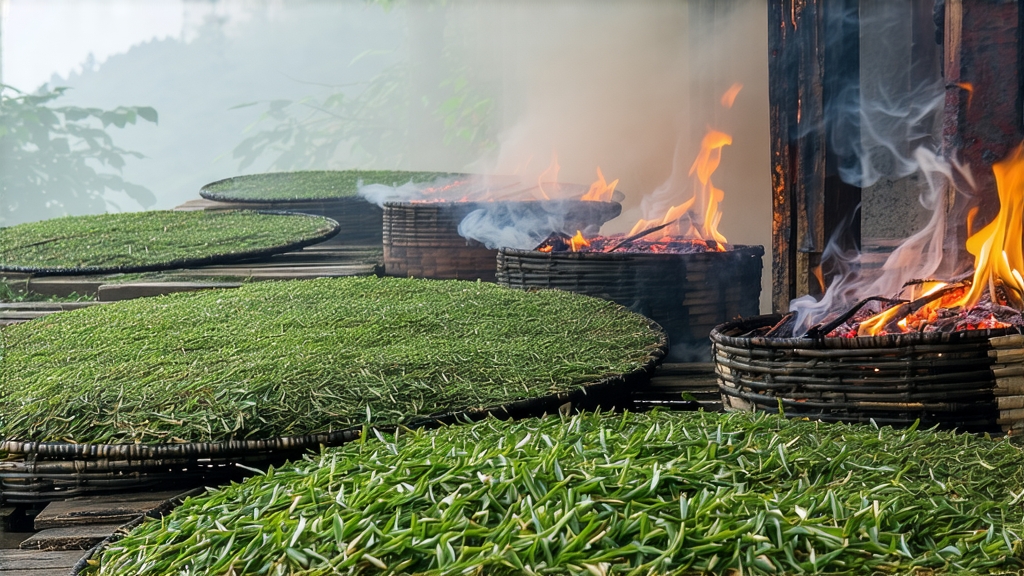
Ask most tea lovers to name the first black tea ever created and they will pause; mention Lapsang Souchong, however, and eyes light up with images of crackling pine logs and campfire sweetness. Hailing from Tongmu village, a protected enclave deep in the Wuyi Mountains of Fujian province, Lapsang Souchong is not merely a tea—it is the primogenitor of every black tea on earth. Its birth, shrouded in the smoke of war and accident, its survival, tied to Dutch merchants and English queens, and its modern reinvention as a connoisseur’s darling, make it the perfect lens through which to understand Chinese red tea—what the West calls “black tea”—in both history and cup.
History: From Martial Urgency to Global Craving
Legend places Lapsang’s origin in 1646, when Qing soldiers quartered themselves in Wuyi tea workshops. To dry the leaves quickly before the troops’ departure, workers spread them over fresh pine fires. The resulting liquor—amber, resinous, unexpectedly mellow—was rushed to Xiamen port where Dutch traders, enchanted by the novel aroma, christened it “bohea” and shipped it to Europe. By the 1660s Catherine of Braganza had made it the status beverage of the English court; by the 1850s it had inspired the tea gardens of Assam and Ceylon. Thus, a wartime improvisation became the template for a global industry.
Terroir: Why Only Tongmu Can Birth the Original
The Wuyi range is a UNESCO dual heritage site where subtropical mists rise from winding ravines, cooling the leaves and concentrating amino acids. At 600–1,200 m elevation, daytime heat and nighttime chill create a 10 °C swing that slows growth and deepens flavor. The soil is a friable, mineral-rich laterite locals call “wuyi red mud,” laced with quartz and manganese that lend a natural sweetness. Crucially, Tongmu sits inside a national nature reserve; pesticides are banned and only indigenous Xiaozhong cultivars—small-leaf, slow to oxidize—are permitted. Move the same bushes 20 km downhill and the signature pine-smoke affinity vanishes.
Leaf Grades: From Souchong to Pekoe
The term “Souchong” refers to the fourth and fifth leaves down the stem—broad, mature, and resilient enough to withstand smoke. Higher up are “Pekoe” tips, downy and delicate. Local pickers grade into four micro-categories:
- Pure Bud Lapsang: only unopened shoots, gently withered without smoke for a honeyed, burgundy liquor.
- Traditional Leaf Lapsang: the classic souchong leaves, withered over pine embers, then smoked three separate times.
- Wuyi Gongfu Lapsang: smaller, twisted leaves processed like Keemun, lightly smoked for a wine-like fragrance.
- Modern “Fruit Style”: cold-smoked with dried longan shells, yielding a sweeter, more accessible cup for new drinkers.
Craft: The Eight Stages of Smoke and Fire
Plucking begins at Qingming festival when leaves reach 4–5 cm. After solar withering on bamboo mats, the leaves are moved into the qinglou—three-story wooden lofts unique to Tongmu. On the ground floor, pine logs (Pinus massoniana) smolder at 40 °C; the rising heat carries resinous volatiles that coat the leaf surface. Every 30 minutes the tea master flips 20 kg piles by hand, ensuring even absorption. Once 60 % moisture is lost, leaves are rolled for 45 minutes to rupture cells and initiate oxidation. Fermentation follows in humid cedar cupboards at 26 °C for 2–3 hours; here chlorophyll breaks down, catechins convert to theaflavins, and the leaf turns from olive to umber. The critical smoking then occurs: leaves are spread on sieves inserted into brick ovens where fresh pine bark and needles release α-pinene and limonene, bonding with leaf sugars to create notes of smoked apricot. Finally, leaves are charcoal-baked at 80 °C to fix the aroma, then rested for 30 days so the smoke softens into a silky, lingering finish.
Chemistry in the Cup
Gas chromatography reveals 42 distinct